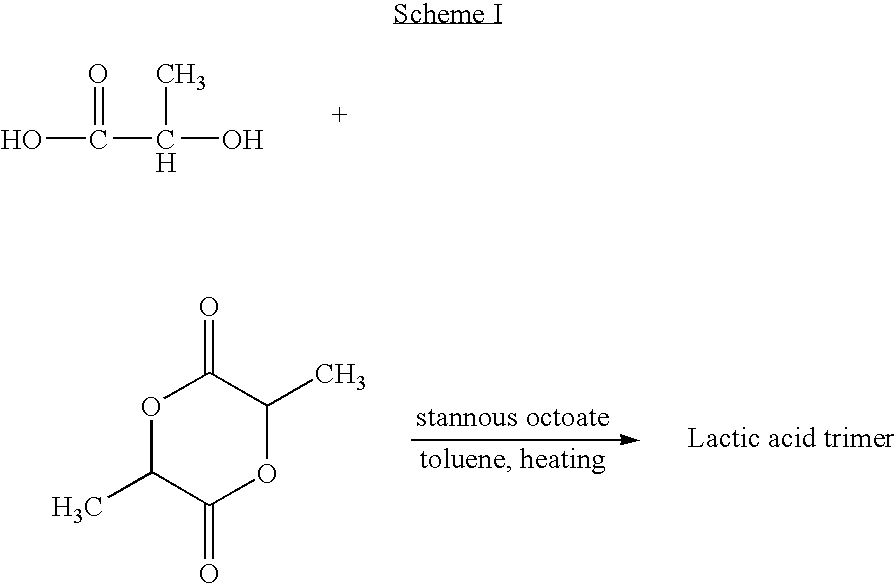Plasticizers for coating compositions
a technology of coating composition and plasticizer, which is applied in the direction of drug composition, prosthesis, peptides, etc., can solve the problems of low elongation, lack of flexibility, and undesirable properties of the articles formed of biodegradable polymers
- Summary
- Abstract
- Description
- Claims
- Application Information
AI Technical Summary
Benefits of technology
Problems solved by technology
Method used
Image
Examples
example 1
Prophetic Synthesis of an Oligomeric Dimer of D,L-Lactide
[0056]In this example, a conventional ring opening polymerization of D,L-lactide is performed using stannous octoate as a catalyst, and 1-hexanol as an initiator. A 2-necked, 100 ml flask equipped with stopcock, septum and stirbar can be flame dried under vacuum, and purged with argon. Inside an argon filled glove box, D,L-lactide (50 gm, 0.347 mol) is placed with stannous octoate (1.41 gm, 0.0347 mol). The reaction mixture can be heated in an oil bath with stirring to 140° C. At time zero, 1-hexanol is added (35.4 gm, 0.347 mol) and the reaction allowed to proceed for 2 hours. The reaction mixture is poured into 500 ml of methanol, the precipitated oil isolated, and dried under vacuum.
example 2
Making a Stent Coating Using the Plasticizer of Example 1
[0057]A first composition can be prepared by mixing the following components:
[0058](a) about 2.0 mass % of poly(D,L-lactide), and
[0059](b) the balance, a 50 / 50 (w / w) blend of chloroform and 1,1,2-trichloroethane.
[0060]The first composition can be applied onto the surface of bare 12 mm small VISION stent (available from Guidant Corporation). The coating can be sprayed and dried to form a primer layer. A spray coater can be used having a 0.014 round nozzle maintained at ambient temperature with a feed pressure 2.5 psi (0.17 atm) and an atomization pressure of about 15 psi (1.02 atm). About 20 μg of the coating can be applied at per one spray pass. Between the spray passes the stent can be dried for about 10 seconds in a flowing air stream at about 50° C. About 100 μg of wet coating can be applied. The stents can be baked at about 80° C. for about one hour, yielding a primer layer composed of approximately 80 μg of poly(D,L-lacti...
example 3
Making a Stent Coating Using a Cyclic Lactide as a Plasticizer
[0067]A layer of parylene™ C, 5 microns thick, is applied to all surfaces of a bare 12 mm small VISION stent (available from Guidant Corporation), by thermal vapor deposition.
[0068]A composition is prepared by mixing the following components:
[0069](a) 0.2 mass % of D,L-lactide monomer,
[0070](b) 2.0 mass % of poly(D,L-lactide),
[0071](c) 2.0 mass % of everolimus, and
[0072](d) the balance, a 50 / 50 blend of acetone and 2-butanone.
[0073]The composition is applied onto only the abluminal surfaces of the VISION stent. Coating is applied using an inkjet microdispenser with CNC controller and imaging system to position the stent under the dispensing nozzle. Six passes are applied with 5 minutes of air drying between each pass. Approximately 300 μg of wet coating is applied. The stents are baked at 60° C. for one hour, yielding a drug reservoir layer composed of approximately 270 μg of coating.
PUM
| Property | Measurement | Unit |
|---|---|---|
| molecular weight | aaaaa | aaaaa |
| molecular weights | aaaaa | aaaaa |
| molecular weight | aaaaa | aaaaa |
Abstract
Description
Claims
Application Information
 Login to View More
Login to View More - R&D
- Intellectual Property
- Life Sciences
- Materials
- Tech Scout
- Unparalleled Data Quality
- Higher Quality Content
- 60% Fewer Hallucinations
Browse by: Latest US Patents, China's latest patents, Technical Efficacy Thesaurus, Application Domain, Technology Topic, Popular Technical Reports.
© 2025 PatSnap. All rights reserved.Legal|Privacy policy|Modern Slavery Act Transparency Statement|Sitemap|About US| Contact US: help@patsnap.com



